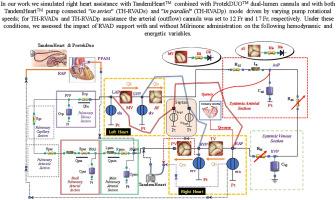The role of TandemHeartTM combined with ProtekDuoTM as right ventricular support device: A simulation approach
IF 4.9
2区 医学
Q1 COMPUTER SCIENCE, INTERDISCIPLINARY APPLICATIONS
引用次数: 0
Abstract
Background and Objective
Right ventricular failure increases short-term mortality in the setting of acute myocardial infarction, cardiogenic shock, advanced left-sided heart failure and pulmonary arterial hypertension. Percutaneous and surgically implanted right ventricular assist devices (RVAD) have been investigated in different clinical settings. The use of the ProtekDuo™ is currently a promising approach due to its features such as groin-free approach leading to early mobilisation, easy percutaneous deployment, compatibility with different pumps and oxygenators, and adaptability to different configurations. The aim of this work was to simulate the behaviour of the TandemHeart™ pump applied “in series” and “in parallel“ mode and the combination of TandemHeart™ and ProtekDuo™ cannula as RVAD using CARDIOSIM© software simulator platform.
Methods
To achieve our aim, two new modules have been implemented in the software. The first module simulated the TandemHeart™ pump in RVAD configuration, both as a right atrial-pulmonary arterial and a right ventricular-pulmonary arterial connection, driven by four different rotational speeds. The second module reproduced the behaviour of the ProtekDuo™ cannula plus TandemHeart™.
Results
The effects induced on the main haemodynamic and energetic variables were analysed for both the right atrial-pulmonary arterial and right ventricular-pulmonary arterial configuration with different pump rotational speed and following Milrinone administration. The TandemHeart™ increased right ventricular end systolic volume by 10 %, larger increases were evident for higher speeds (6000 and 7500 rpm) and connections with 21-Fr inflow and 17-Fr outflow cannula, respectively. Both TandemHeart™ and ProtekDuo™ support increased left ventricular preload. When different RVAD settings were used, Milrinone therapy increased the left ventricular pressure-volume area and decreased the right pressure-volume area slightly. A reduction in oxygen consumption (demand) was observed with reduced right stroke work and pressure volume area and increased oxygen supply (coronary blood flow).
Conclusions
The outcome of our simulations confirms the effective haemodynamic assistance provided by the ProtekDuo™ as observed in the acute clinical setting. A simulation approach based on pressure-volume analysis combined with modified time-varying elastance and lumped-parameter modelling remains a suitable tool for clinical applications.

TandemHeartTM 结合 ProtekDuoTM 作为右心室支持装置的作用:模拟方法
背景和目的 在急性心肌梗死、心源性休克、晚期左心衰竭和肺动脉高压的情况下,右心室衰竭会增加短期死亡率。经皮和手术植入的右心室辅助装置(RVAD)已在不同的临床环境中进行了研究。使用 ProtekDuo™ 是目前一种很有前景的方法,因为它具有无需腹股沟的方法,可实现早期动员,易于经皮部署,与不同的泵和氧合器兼容,并可适应不同的配置等特点。这项工作的目的是使用 CARDIOSIM© 软件模拟器平台模拟 TandemHeart™ 泵 "串联 "和 "并联 "模式的应用行为,以及 TandemHeart™ 和 ProtekDuo™ 插管组合作为 RVAD 的行为。第一个模块模拟了 RVAD 配置中的 TandemHeart™ 泵,包括右心房-肺动脉和右心室-肺动脉连接,由四种不同的转速驱动。第二个模块再现了 ProtekDuo™ 插管和 TandemHeart™ 的行为。结果分析了右心房-肺动脉和右心室-肺动脉配置下不同泵转速和米力农给药后对主要血流动力学和能量变量的影响。TandemHeart™ 使右心室收缩末期容积增加了 10%,在转速较高(6000 和 7500 rpm)以及分别连接 21-Fr 流入套管和 17-Fr 流出套管时,增加幅度更大。TandemHeart™ 和 ProtekDuo™ 都支持增加左心室前负荷。当使用不同的 RVAD 设置时,米力农疗法增加了左心室压力-容积面积,而右心室压力-容积面积略有减少。结论我们的模拟结果证实了 ProtekDuo™ 在急性临床环境中提供的有效血流动力学支持。基于压力-容积分析的模拟方法结合改进的时变弹性和整块参数建模仍然是临床应用的合适工具。
本文章由计算机程序翻译,如有差异,请以英文原文为准。
求助全文
约1分钟内获得全文
求助全文
来源期刊

Computer methods and programs in biomedicine
工程技术-工程:生物医学
CiteScore
12.30
自引率
6.60%
发文量
601
审稿时长
135 days
期刊介绍:
To encourage the development of formal computing methods, and their application in biomedical research and medical practice, by illustration of fundamental principles in biomedical informatics research; to stimulate basic research into application software design; to report the state of research of biomedical information processing projects; to report new computer methodologies applied in biomedical areas; the eventual distribution of demonstrable software to avoid duplication of effort; to provide a forum for discussion and improvement of existing software; to optimize contact between national organizations and regional user groups by promoting an international exchange of information on formal methods, standards and software in biomedicine.
Computer Methods and Programs in Biomedicine covers computing methodology and software systems derived from computing science for implementation in all aspects of biomedical research and medical practice. It is designed to serve: biochemists; biologists; geneticists; immunologists; neuroscientists; pharmacologists; toxicologists; clinicians; epidemiologists; psychiatrists; psychologists; cardiologists; chemists; (radio)physicists; computer scientists; programmers and systems analysts; biomedical, clinical, electrical and other engineers; teachers of medical informatics and users of educational software.
 求助内容:
求助内容: 应助结果提醒方式:
应助结果提醒方式:


